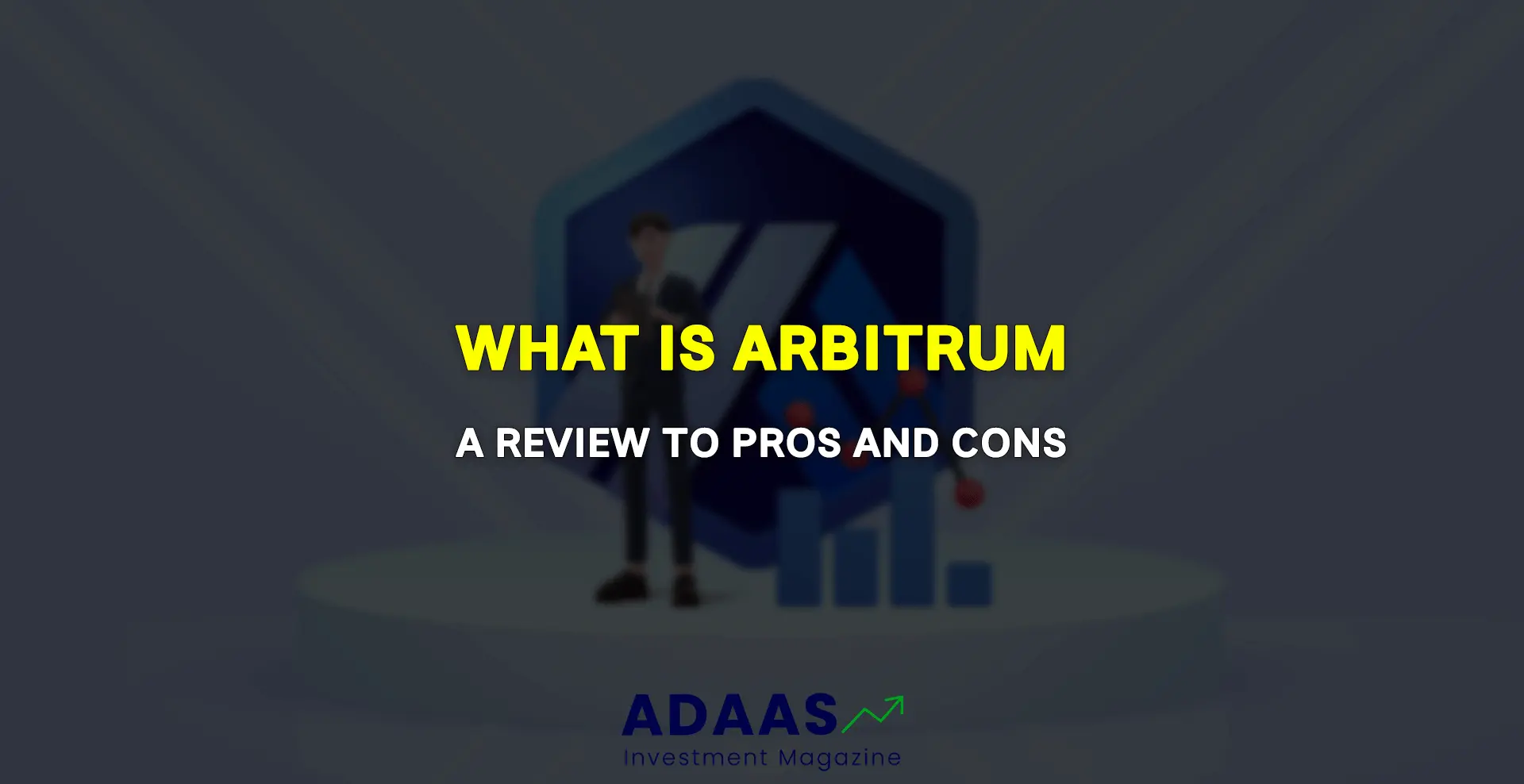What Is Arbitrum? Pros And Cons Of Optimism Roll Ups.
Learn about its benefits, potential drawbacks, and how it revolutionizes transaction processing on the Ethereum network.
By reading the article “What Is Arbitrum” published in Adaas Investment Magazine, you will be fully familiar with this layer-2 solution for the Ethereum Blockchain challenges such as stability and its pros and cons! This level of familiarity can be enough when you need educational information about this topic.
This podcast is published for you!
In the fast-paced world of cryptocurrency, Ethereum has emerged as a leading blockchain platform. However, as Ethereum’s popularity has grown, so have the challenges associated with its scalability. Enter Layer 2 scaling solutions, a game-changing concept that aims to overcome these hurdles and unlock the full potential of Ethereum.
Layer 2 scaling solutions are protocols or frameworks built on top of the Ethereum network that offer increased transaction throughput and improved efficiency. These solutions work by processing transactions off-chain, relieving the burden on the Ethereum mainnet while maintaining the network’s security and decentralization.
One such prominent Layer 2 scaling solution is Arbitrum. Developed by Offchain Labs, Arbitrum is an optimistic rollup technology that has garnered attention for its potential to address Ethereum’s scalability concerns. Optimistic rollups, in general, are Layer 2 solutions that bundle multiple transactions into a single batch and submit them to the Ethereum mainnet as a single transaction, reducing congestion and gas fees.
The purpose of this blog post is to delve into the world of Arbitrum, exploring its pros and cons as an optimistic rollup solution. We’ll take a close look at its unique features and examine both the advantages and limitations it brings to investors. By the end of this article, you’ll have a comprehensive understanding of Arbitrum and be able to make informed decisions about its potential applications.
Table of Contents
What is Arbitrum?
Arbitrum is an innovative optimistic rollup technology that aims to address Ethereum’s scalability challenges by offering a Layer 2 scaling solution. It works by processing transactions off-chain, bundling them together, and then submitting them to the Ethereum mainnet as a single transaction. This process greatly enhances the scalability of Ethereum, allowing it to handle a significantly higher volume of transactions and reducing congestion on the mainnet.
Key Features of Arbitrum:
Off-chain Computation: One of the key features of Arbitrum is its ability to perform complex computations off-chain. By moving computations away from the Ethereum mainnet, Arbitrum significantly reduces the processing burden on the network, resulting in faster and more efficient transaction processing.
Optimistic Dispute Resolution: Arbitrum employs an optimistic approach to dispute resolution. It assumes that most transactions are valid and only intervenes in case of suspected fraud or discrepancies. This approach helps achieve faster transaction finality and reduces the need for on-chain verification for every transaction.
How does Arbitrum work?
Transaction Aggregation: Arbitrum collects multiple transactions from users and bundles them together off-chain into what is called a “rollup.” These rollups can include a large number of individual transactions, effectively reducing the number of transactions that need to be processed on the Ethereum mainnet.
Transaction Execution: Once bundled, the rollup is submitted to the Ethereum mainnet as a single transaction, reducing congestion and gas fees. The Ethereum mainnet serves as a security anchor, ensuring the integrity and immutability of the rollup.
Optimistic Verification: After the rollup is submitted, the transactions within it are assumed to be valid by default. However, a dispute resolution period is provided during which anyone can submit a proof of fraud if they believe a transaction is invalid. This optimistic approach allows for faster transaction confirmation while still maintaining the ability to address fraudulent activity if necessary.
The Role of Arbitrum in Scaling Ethereum:
Arbitrum plays a critical role in scaling Ethereum by increasing the network’s transaction capacity and reducing congestion. By offloading computations and bundling transactions off-chain, Arbitrum enables Ethereum to process a significantly higher number of transactions per second (TPS). This increased scalability opens up possibilities for various applications, including decentralized finance (DeFi), gaming, and non-fungible tokens (NFTs), that require high transaction throughput.
In addition to scalability, Arbitrum offers compatibility with existing Ethereum smart contracts, allowing developers to seamlessly deploy their contracts on the Arbitrum network. This interoperability ensures that projects can easily transition to Arbitrum without the need for extensive code modifications, enhancing the adoption of this Layer 2 solution.
Overall, Arbitrum’s off-chain computation, optimistic dispute resolution, and seamless integration with Ethereum’s mainnet make it a promising technology for scaling Ethereum and unlocking its full potential.
In the following sections, we will explore the pros and cons of Arbitrum in more detail, helping you gain a comprehensive understanding of its benefits and limitations.
Pros of Arbitrum:
Scalability:
Arbitrum stands out as a powerful solution to address Ethereum’s scalability issues, paving the way for a more efficient and scalable network. Here are the key advantages of Arbitrum’s scalability:
Enhanced Transaction Throughput: Arbitrum’s optimistic rollup technology significantly increases Ethereum’s transaction processing capacity. By bundling multiple transactions into a single rollup and submitting it to the Ethereum mainnet, Arbitrum unlocks the potential for a significantly higher number of transactions per second (TPS). This improved throughput enables Ethereum to handle a larger volume of transactions, accommodating the growing demand from users and decentralized applications (DApps).
Reduced Ethereum Gas Fees: One of the primary pain points on the Ethereum network has been high gas fees during periods of congestion. With Arbitrum, users can enjoy the potential for reduced gas fees. By processing transactions off-chain and submitting them as a single transaction to the Ethereum mainnet, Arbitrum alleviates congestion and reduces the overall gas costs associated with transaction execution. This cost reduction makes Ethereum more accessible and affordable for users and developers.
Faster Confirmation Times: Arbitrum’s scalability enhancements result in faster confirmation times for transactions. By bundling transactions off-chain and submitting them as a single batch, Arbitrum reduces the time it takes for transactions to be processed and confirmed on the Ethereum mainnet. This improved efficiency translates to quicker transaction settlement, allowing users to experience near-instantaneous transaction finality.
Compatibility and Interoperability:
Arbitrum’s compatibility and interoperability features make it an attractive choice for developers and projects within the Ethereum ecosystem. Here’s why:
Seamless Integration with Existing Ethereum Smart Contracts: Arbitrum maintains full compatibility with existing Ethereum smart contracts. Developers can deploy their contracts on Arbitrum without the need for significant modifications or rewriting of code. This compatibility ensures a smooth transition for projects, allowing them to leverage the benefits of Arbitrum’s scalability without disrupting their existing infrastructure or user base.
Interoperability with the Ethereum Mainnet: Arbitrum seamlessly integrates with Ethereum’s mainnet, creating a cohesive ecosystem. By leveraging Ethereum’s mainnet as a security anchor, Arbitrum ensures that transactions processed on its rollup are backed by the robustness and decentralization of the Ethereum network. This interoperability enables developers and users to seamlessly interact with applications on both Arbitrum and the Ethereum mainnet, expanding possibilities and fostering growth.
Attracting Existing Ethereum Developers and Projects: Arbitrum’s compatibility and interoperability make it an appealing choice for existing Ethereum developers and projects. The ability to migrate contracts to Arbitrum with ease enables developers to tap into the benefits of improved scalability and reduced gas fees without the need for extensive code modifications. This compatibility not only encourages adoption but also facilitates the growth and expansion of the Ethereum ecosystem as a whole.
Cons of Arbitrum:
Centralization Concerns:
While Arbitrum offers significant benefits, it is important to consider potential centralization risks associated with its design. Here are some key concerns:
Role of Trusted Validators: Arbitrum’s operation relies on a set of trusted validators who are responsible for validating and processing transactions. This introduces a level of centralization, as the protocol depends on the actions and decisions of these validators. Users must place trust in the validators and the Arbitrum team to act in the best interest of the network. In cases where validators act maliciously or collude, the security and integrity of the system could be compromised.
Influence of Validators: The validator set in Arbitrum has the power to influence the protocol’s operation. Their actions can impact transaction processing, dispute resolution, and the overall performance of the network. This concentration of power in the hands of a limited number of validators raises concerns about potential governance issues and the risk of undue influence on the network’s direction and policies.
Time Delay and Latency:
Another limitation of Arbitrum’s optimistic rollup design is the inherent time delay in transaction settlement and dispute resolution. Consider the following factors:
Dispute Resolution Period: In Arbitrum, there is a defined dispute resolution period during which users can challenge the validity of transactions. This period introduces a time delay before funds can be withdrawn from the rollup. Users must wait for the resolution process to complete, which can take some time depending on the complexity of the dispute. This delay may impact the user experience, especially in time-sensitive applications that require quick and immediate transaction settlement.
Potential Latency Issues: While Arbitrum aims to provide faster confirmation times compared to the Ethereum mainnet, it is still subject to potential latency issues. The off-chain processing and subsequent submission of transactions to the Ethereum mainnet introduce an additional layer of complexity that can impact the speed of transaction execution. Users should consider the potential latency and its implications, especially in applications that require real-time interactions or high-frequency trading.
Limited Smart Contract Functionality:
Arbitrum’s design may impose limitations on the types of smart contracts that can be deployed on the platform. Consider the following aspects:
Optimization for Arbitrum’s Design: Smart contracts deployed on Arbitrum may need to be optimized specifically for its rollup architecture. Certain types of complex computations or specialized functionality may not be readily compatible or may require modifications to fit within the limitations and constraints of Arbitrum’s design. This can pose challenges for projects that rely on intricate smart contract logic or require advanced computational capabilities.
Restrictions on Contract Interactions: Arbitrum’s rollup design may impose certain restrictions on how contracts can interact with each other. This limitation can affect the interoperability and composability of contracts within the Arbitrum ecosystem. Projects that heavily rely on complex contract interactions may need to carefully evaluate the compatibility and adaptability of their contracts to work effectively within Arbitrum’s constraints.
While Arbitrum offers scalability and other benefits, it is essential to consider the potential centralization concerns, time delays, and limitations on smart contract functionality. By weighing these factors, developers and users can make informed decisions about utilizing Arbitrum for their specific use cases within the Ethereum ecosystem.
The Important Stats Of Arbitrum
To use any platform in the blockchain ecosystem, it is better to consider some important metrics such as daily active users to get an overview of the network situation. You can find many platforms that provide this data for free.
We have placed two examples for you, but you should get fresh data every time you want to analyze a platform!
Conclusion
In conclusion, Arbitrum emerges as a prominent optimistic rollup solution that addresses Ethereum’s scalability challenges while introducing its own set of considerations. Let’s recap the main points discussed in this blog post and provide a balanced perspective on the benefits and drawbacks of Arbitrum:
Arbitrum offers scalability by significantly increasing Ethereum’s transaction throughput, potentially reducing gas fees, and improving confirmation times. It provides a promising path to overcome the limitations of the Ethereum network.
The compatibility and interoperability features of Arbitrum allow for seamless integration with existing Ethereum smart contracts, attracting developers and projects within the Ethereum ecosystem. This compatibility eases the transition to Arbitrum while fostering the growth and expansion of decentralized applications.
However, it’s essential to acknowledge the potential drawbacks of Arbitrum. Centralization concerns arise due to the reliance on trusted validators and their influence on the protocol’s operation. Users must trust the validators and the Arbitrum team, raising questions about decentralization and governance.
Time delay and latency are inherent to Arbitrum’s optimistic rollup design. The dispute resolution period introduces a waiting period before funds can be withdrawn, potentially affecting user experience, especially in time-sensitive applications. Latency issues can also arise due to the additional layer of off-chain processing and submission to the Ethereum mainnet.
Moreover, certain limitations on smart contract functionality and interactions may require optimization and careful consideration. Complex computations or specialized functionalities may pose challenges for projects that heavily rely on intricate smart contract logic.
It is important to note that while Arbitrum shows promise, readers should conduct further research and analysis to determine its suitability for specific use cases. Each project has unique requirements and considerations, and understanding the trade-offs between scalability, centralization concerns, time delays, and smart contract limitations is crucial.
In the rapidly evolving landscape of blockchain technology, solutions like Arbitrum play a significant role in enhancing the capabilities of Ethereum. By providing scalability and compatibility, Arbitrum offers new possibilities for developers and users alike. However, it is essential to approach its adoption with careful consideration and a comprehensive understanding of both the benefits and drawbacks.
Ultimately, by staying informed and conducting thorough evaluations, individuals and projects can make informed decisions regarding the adoption of Arbitrum as a scaling solution within the Ethereum ecosystem.

The End Words
At Adaas Capital, we hope that by reading this article you will be fully immersed in The Arbitrum & Pros And Cons Of Optimism Roll Ups! You can help us improve by sharing this post which is published in Adaas Investment Magazine and help optimize it by submitting your comments.
FAQ
Which is better Arbitrum or Optimism?
Ultimately, the best solution for you will depend on your specific needs. If you need the fastest possible transaction speeds and the lowest possible fees, then Arbitrum is the better choice. If you need full EVM compatibility and you’re concerned about security, then Optimism may be a better choice.
Is it safe to use Arbitrum?
Arbitrum is generally considered to be a safe platform to use. It is built on top of Ethereum, which is one of the most secure blockchains in the world. Arbitrum also uses a number of security measures to protect user funds. However, no platform is 100% secure, so it is important to do your own research and understand the risks involved before using Arbitrum.
What is Arbitrum pricing?
Arbitrum pricing is the process of determining the price of Arbitrum tokens (ARB). The price of ARB is determined by supply and demand, and is influenced by a number of factors, including the growth of the Ethereum ecosystem and the adoption of Arbitrum by developers and users.
How long does it take to get money out of Arbitrum?
It usually takes 7 days to withdraw money from Arbitrum to Ethereum. This is because Arbitrum uses a security mechanism called fraud proofs, which requires a certain amount of time to be processed. However, there are some third-party services that offer faster withdrawal for a fee.








